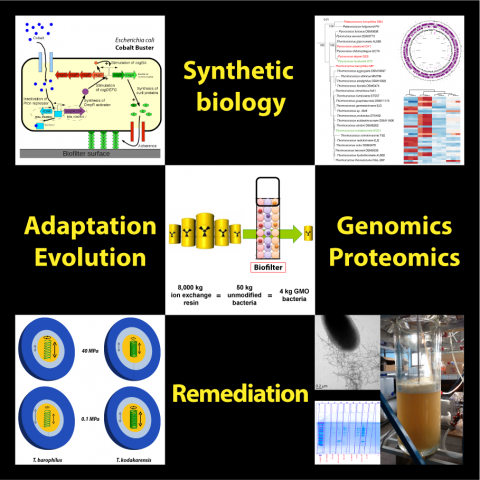Microbiology of extreme environments
 The M2E team aims first at generating breakthrough science on the adaptation of microorganisms to extreme environments using a multidisciplinary approach ranging from atom physics to up-to-date omics methods and classical culturing approaches and use this fundamental knowledge to develop innovative biotechnological solutions, focussing on Archaea as a source of genes of biotechnological interest, and synthetic biology as a genetic approach to improve microbial-assisted pollutants removal and sequestration.
The M2E team aims first at generating breakthrough science on the adaptation of microorganisms to extreme environments using a multidisciplinary approach ranging from atom physics to up-to-date omics methods and classical culturing approaches and use this fundamental knowledge to develop innovative biotechnological solutions, focussing on Archaea as a source of genes of biotechnological interest, and synthetic biology as a genetic approach to improve microbial-assisted pollutants removal and sequestration.
The optimal conditions for the development of humans (atmospheric pressure, neutral pH, ca. 25°C, 21% oxygen, organic carbon, etc.) define the so-called normal environment, and consequently environmental variables that substantially deviate from these conditions define the so-called extreme habitats. Only a few decades ago, it was thought that most of these extreme environments were too hostile to harbor life. However, it is now admitted that possibly no place on Earth is too extreme for life, and that the majority of life on Earth dwells in these "extreme" environments, especially in the deep-biosphere. These environments are inhabited by organisms, adapted to these extreme conditions, to which the anthropomorphic normality is perceived as extreme conditions. These so-called extremophiles exhibit possible genomic and structural adaptations to cope with their specific environmental conditions. Extremophiles have interest both at the fundamental level, since they provide a window on adaptation strategies, and thus novel ways to imagine life. In addition, extremophiles offer a window on early Earth biotopes to study the origins of life. Extremophiles also have interest for biotechnology since they code for enzymes active in very different chemical conditions, as well as totally novel biochemical functions. For example, genome sequences of the polyextremophiles the M2E team studies, the Thermococcales, only contain ca. 35% of genes that can be associated with a putative function, and therefore 65% of novel genes of unknown structure and function. They therefore constitute an untapped resource of novel functions and genes with potential application for a "greener" biotechnology. Extremophiles also provide the opportunity to increase the domain of physico-chemical conditions relevant for biotechnology (high temperature, high pressure, extreme pH, etc.), increasing the domain of application of biology-based industrial solutions. The domain of application which is the savoir-faire of the team is pollutant removal (2 patents) and 2 projects are currently developed with industrial partners).The team project is organized along two complementary research axes:

